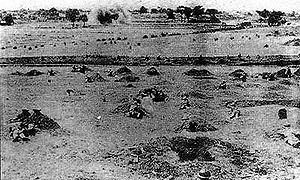Battle of Suixian-Zaoyang
| Battle of Suixian–Zaoyang | |||||||
|---|---|---|---|---|---|---|---|
| Part of the Second Sino-Japanese War | |||||||
 NRA troops in an attack |
|||||||
|
|||||||
| Belligerents | |||||||
|
|
|
||||||
| Commanders and leaders | |||||||
|
|
|
||||||
| Strength | |||||||
| 220,000 troops in 2 Armies: Right Flank Army (29th and 33rd Army Groups), Left Flank Army (11th Army Group), 4 other Army Groups: 31st, 21st, 2nd, and 22nd Army Groups, and a River Defense Force. | 113,000 troops in 3 divisions: 3rd, 13th and 16th, and the 4th Cavalry Brigade | ||||||
| Casualties and losses | |||||||
| 28,000 men | 21,000 men | ||||||
The Battle of Suixian–Zaoyang (simplified Chinese: 随枣会战; traditional Chinese: 隨棗會戰; pinyin: Suízǎo Huìzhàn), also known as the Battle of Suizao was one of the 22 major engagements between the National Revolutionary Army (NRA) and Imperial Japanese Army (IJA) during the Second Sino-Japanese War. The Japanese launched a major two-pronged offensive that captured many cities and towns. However, their failure to defend against a series of coordinated Chinese counter-attacks forced them to completely withdraw, resulting in territorial control returning to the original status quo.
At the end of April 1939, Japanese commanders sought to capitalise on their gains from their successful capture of Wuhan, as well as to relieve pressure on their base in the newly captured city. Thus, they deployed 113,000 troops in three divisions and one cavalry brigade to launch two simultaneous attacks on the cities of Suizhou and Zaoyang, along the Xiangyang-Huayuan Highway and Jingshan-Zhongxiang Highway respectively.
Japanese commander General Yasuji Okamura deployed the 13th and 16th Divisions from Zhongxiang to drive northwards along the Dahong mountain ranges and attack Zaoyang from the south on 1 May 1939. Zaoyang was protected by the Chinese 77th Corps. The single Chinese corps held fast against the fierce attack by the two Japanese divisions.
On 3 May, Japanese commander Lieutenant General Yamawaki Masataka dispatched the 3rd Division and 4th Cavalry Brigade to attack Suixian and Tongbai from Yingshan and Xinyang respectively in an attempt to surround Tang Enbo and Li Pingxian's 11th and 31st Army Groups. Four days later, the 13th and 16th Divisions broke through Chinese 77th Corps' defensive lines, and successfully captured Zaoyang. By 12 May, the two Japanese divisions had also captured Tanghe, Nanyang and Xinye.
...
Wikipedia
